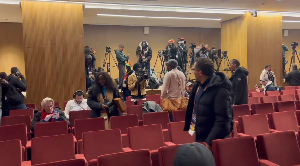The posters and knickknacks that decorate Emmanuel Nsiah's University of Vermont dorm room are an eclectic mishmash of what he likes and what is most important to him.
The 22-year-old sophomore likes Latin pop-star diva Shakira. She hangs on the wall next to L.A. Laker Kobe Bryant and across the room from a large action shot of Toronto Raptor Vince Carter.
Nsiah is also partial to Pablo Picasso and Nelson Mandela, whom he calls a hero.
"Mandela," he says, referring to his poster of the South African civil rights leader. Nsiah's tongue is still thick with his native Ghanaian accent. "He is passionate about humans, like Ghandi."
From his West African roots to the swatches of black and white American culture he has absorbed along the way, Nsiah has brought the diverse patchwork of his life to UVM, which is struggling to diversify its mostly white, middle-class campus.
When Nsiah and his friend, fellow UVM sophomore Nana Minkah, talk about Ghana, knowing smiles cross their faces. They grew up in Kumasi, the capital of Ghana's Ashanti region and the nation's second-largest city. Located in the south-central part of the country, Kumasi is a city of more than 2.5 million people. It is where they felt most at home -- among family and friends.
Both students were 17 when their parents, in search of better educational and career opportunities, left Ghana for the Bronx, where their African culture blended with myriad others in New York City's racial melting pot. That is where Nsiah and Minkah attended a high school of about 3,000 black, white, Hispanic and immigrant students. Then came college. For the first time in their lives, Nsiah and Minkah would become keenly aware that they were among the minority.
"Physically, you see you are black and your fellow students are white," said Minkah, 21, who shares his friend's accent, although it is less pronounced. "But when it comes to socializing, you don't see that; you do it as equals." No big bumps
Nsiah and Minkah, who didn't really know each other until college, say there have been no major bumps in the road when it comes to fitting in as black students on a campus that is 94 percent white.
The two men describe their lives on campus as a mix of keeping in touch with other minorities and mixing in with students of all backgrounds. Minkah, an art major, and Nsiah, who studies biology, say their friendships with other students have been formed, not based on skin color, but on interests. Nsiah estimates half his friends are white and half are black. Minkah, who has met many of his buddies through intramural football and soccer, says just about all the people he hangs out with are white.
Still, Minkah and Nsiah do spend a lot of time with other black UVM students as participants in the Africa House Program. This year's Africa House group lives together in a suite of rooms at the Living/Learning Center. Participants are immersed in African life through academic and cultural studies.
Nsiah belongs to UVM's Black Student Union, and both he and Minkah participate in activities offered by the African Latino Asian Native American (ALANA) Student Center. The program is touted by the university as a "safety net" for prospective and current students of color. One of its goals is to be like a second family for members.
Nsiah adds that his transition from the nearly all-minority Christopher Columbus High School to UVM was made easier because of the university's connection with Columbus.
Since 2001, UVM has attracted -- partially through strong financial aid packages -- 50 minority students from the northeast Bronx high school as part of the university's effort to enrich its mostly white campus.
"There are some Columbus students here," he said, "so you know some people already when you come."
Like most Columbus students, Nsiah needed help paying most of UVM's more than $30,000 for tuition, room and board, and he received that help. UVM's financial aid package, he said, was the best among his other college considerations. Friendly people
In visiting UVM for the first time, Minkah and Nsiah said they were struck by how friendly everyone seemed on campus and in the downtown waterfront community of Burlington. They compared the hometown feel of the small city to their native Ghana, where the men said they felt safer than in the Bronx.
They had no comparison, however, for the early falls and icy, long winters of northwestern Vermont.
"I got sick," Minkah said, describing his failed attempt at adjusting to the weather change between New York City and frigid Vermont.
"When I came, that year was really cold," Nsiah said. "I was even thinking about transferring because of the weather."
But, they say, the weather has been an incidental factor in an overall favorable college experience.
The one blemish came in November, after learning that a UVM police officer who was looking for a black male robbery suspect stopped a black female student, whom he handcuffed and held at gunpoint.
Their perceived atmosphere of racial harmony at UVM was called into question.
"I was kind of shocked," said Nsiah, who said he closely followed details of the arrest on the campus Web site. "To mistake a guy for a woman and arrest somebody. I was kind of shocked."
Minkah worried the racially charged incident would prompt white students to be suspicious of black students.
"To me, it was personal," he said. "What people would think about me, with a black student getting arrested? If you go out at night and you meet someone of a different race, what are they going to think?"
Nsiah says he appreciated UVM President Daniel Fogel's reaction to what happened. Within a day of the incident, Fogel ordered investigations into police conduct and residence-hall security, met with the student whom police had detained, and held a two-hour meeting with a group of 30 students at the ALANA Student Center. Eventually, the officer was fired.
"I kind of, like, trusted his words," Nsiah said of Fogel. "I was wanting to know what was going to happen and he told us."
Contact Jill Fahy at 660-1898 or jfahy@bfp.burlingtonfreepress.com
Diaspora News of Sunday, 7 March 2004
Source: burlingtonfreepress












